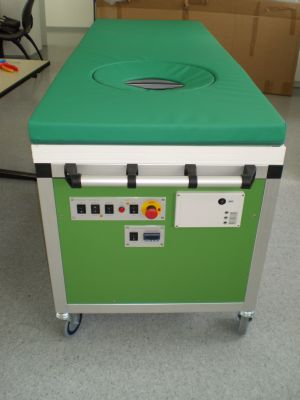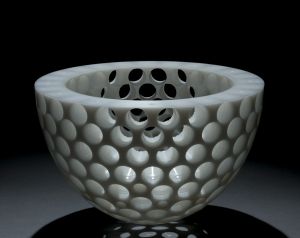About ten percent of the women in the western world suffer from breast cancer, about 30 % die from metastases. 3D ultrasonic computer tomography supplies high-resolution and reproducible images and, hence, represents a promising process for early diagnosis. To turn this prototype into a standard device, however, the researchers are required to speed up image processing considerably. With this in mind, KTI scientists are doing research into accelerated algorithms and high-performance hardware architectures.
When discovered, a tumor in the breast has an average size of 1 cm. In 30 percent of all cases, metastases have already developed. At the Institute for Data Processing and Electronics (IPE), scientists have now set up the first 3D ultrasound computer tomograph worldwide, which records high-resolution images of the breast. “The device has the potential of also detecting much smaller tumors,” says Dr. Nicole Ruiter from IPE. “We hope to reach a mean tumor size of 5 mm at the time of diagnosis. In this case, the probability of metastasis development is 5 % only.”

Examination table for 3D ultrasound
computer tomography. (Photo: IPE)
With more than 1000 sensors surrounding the breast, the ultrasound computer tomograph records the data. For a three-dimensional representation of highest resolution, however, the process presently still needs several weeks of computing time. With reasonable limitations, such as images of individual layers, the process is accelerated, but optimum use in clinical practice still requires a considerable speed-up of image reconstruction.
Apart from the development of adequate algorithms for image reconstruction, high-performance hardware has to be supplied. “It must not only offer high computing power, but also be flexible and affordable,” says Dr. Michael Hübner from the Institute of Information Processing Technologies (ITIV). The scientists are therefore working on linking various high-performance computer architectures. Among others, they want to use the field-programmable gate arrays (FPGA) that are applied for data acquisition in the ultrasound computer tomograph also for computing. The team headed by Matthias Balzer (IPE) has developed and optimized this hardware specially for large data volumes and high computing powers. “With the 80 parallel FPGAs, we are given enormous advantages in speed. In addition, dynamic reconfiguration, that is reuse of existing chip surface for repeated calculations, will enable us to integrate onto the chips several processors in a sequence,” says Hübner. “This will reduce energy consumption of the system and later cost of operation.”
With the raw data from ultrasound computer tomography, they test algorithms for image reconstruction on traditional microprocessors, the FPGAs or graphics processors as applied in commerical PCs. The team wants to stay as flexbile as possible. Only then can new developments in algorithmics be implemented rapidly. In their Ph. D. theses, Matthias Birk (IPE) and Peter Figuli (ITIV) are presently investigating this field. It is aimed at speeding up the process by the factor of 100. In the long term, data processing in real time is envisaged. Then, the process might also be used for therapy, as ultrasound focused at high energy can burn tissue and may, hence, represent an alternative to operation.
The German Research Foundation is funding the joint project of the Institute for Data Processing and Electronics (IPE) headed by Professor Marc Weber and the Institute of Information Processing Technologies (ITIV) headed by Professor Jürgen Becker for two years.
In close partnership with society, KIT develops solutions for urgent challenges – from climate change, energy transition and sustainable use of natural resources to artificial intelligence, sovereignty and an aging population. As The University in the Helmholtz Association, KIT unites scientific excellence from insight to application-driven research under one roof – and is thus in a unique position to drive this transformation. As a University of Excellence, KIT offers its more than 10,000 employees and 22,800 students outstanding opportunities to shape a sustainable and resilient future. KIT – Science for Impact.

